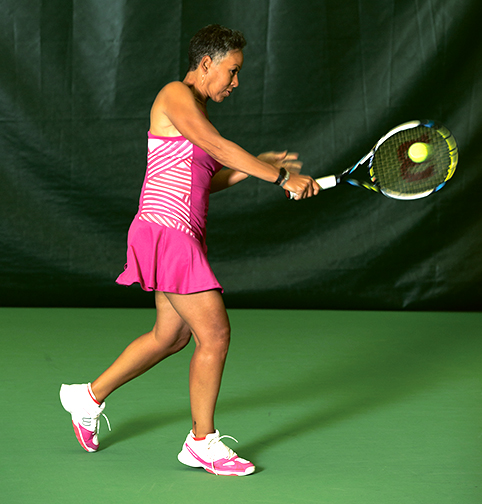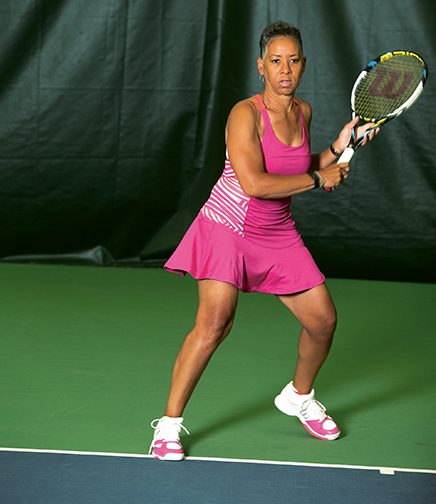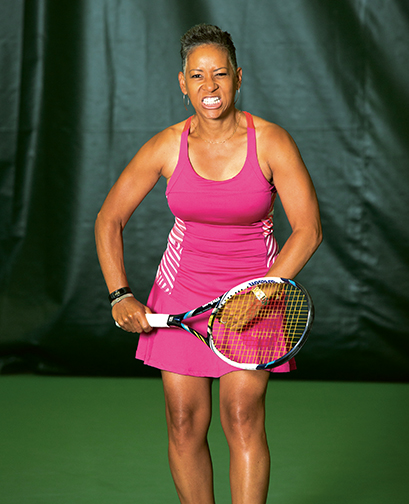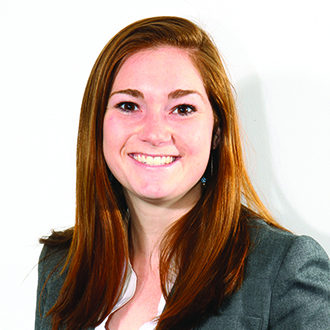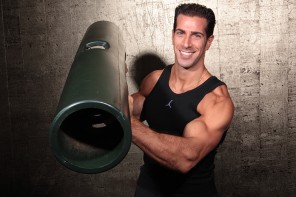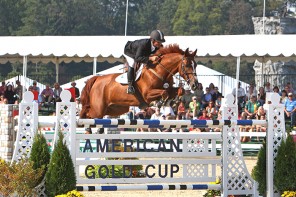Katrina M. Adams hits the court at Life Time Athletic in Harrison. Photographs by John Rizzo.
The United States Tennis Association — whose marquee event, the US Open, kicks off Aug. 31 — has been undergoing something of a transformation of late. There’s an 11-year deal with ESPN, set to begin its second year; and new construction of two courts at the Billie Jean King National Tennis Center and a retractable roof on its Arthur Ashe Stadium, to be completed next year.
There’s also a new face — USTA Chairman of the Board, CEO and President Katrina M. Adams.
Six months into her tenure at the helm of the Harrison-based organization, she is no stranger to USTA or the sport it serves. Known for grace and power on the court — once ranked No. 67 in singles and as high as No. 8 in women’s doubles — Adams is the first former professional player, and the first African-American, to take on the role. She has also been a member of the USTA board of directors for 10 years, including a two-year stint as first vice president.
Her grace and power were very much in evidence during a wide-ranging conversation with WAG in the Tennis Lounge of neighboring Life Time Athletic that she clearly relished. “I’m enjoying this,” she says at one point. A product of Chicago and the daughter of educators, Adams is as fiercely interested in the inner game as she is in the outer one.
“I think the game has really gotten away from the morals of the sport,” she says. “It really starts at the top with the coaches and the parents.”
And the USTA, she adds, has the responsibility of setting the rules for how the participants conduct themselves at its tournaments.
Increased sportsmanship is one of the three initiatives she plans to implement during her two-year stint.
Another is outreach to the 400,000 high school tennis players around the country, whom she’d like to keep in the game beyond the eight-week school season. Adams said she wants to “make sure that we have opportunities for them to be competitive recreationally” in what she called “the sport of a lifetime.”
While there are those who would like to see a star or two emerge from today’s juniors — knowing that would increase the American audience — Adams counters: “You can’t create a champion. A champion comes from within. You can teach all the tools necessary to be a champion, but to be a true champion, it comes from within because you have to have a certain level of grit, steel, passion to go that extra mile.”
Her first priority, however, is involving the Hispanic community in the game.
“It’s the fastest-growing demographic in America, and it’s the smallest group that we actually serve,” she says. “My main goal is to introduce the sport to more diverse communities within the Hispanic culture, to embrace them and include them in the process of learning how to play tennis.”
It’s really no surprise that she is taking a grassroots approach, because that was her introduction to the sport.
At age 6, she tagged along with her older brothers to a summer program four blocks from their house on Chicago’s West Side while their parents taught summer school.
“It wasn’t really your normal tennis program,” she says of the Boys Club offering in the summer of 1975. After a few weeks of watching her brothers play, Adams, too young to participate in the 9-and-up program, persuaded the coaches to let her play.
“I loved it from the first moment I struck a tennis ball,” she says.
Her brothers never played after the end of that summer, but she was a natural.
And what sealed the deal was that same summer she watched Arthur Ashe become the first African-American man to win Wimbledon as he defeated Jimmy Connors.
“I had just started playing and a couple weeks later I see this black guy on a 12-inch black-and-white television,” she says. “It was like, ‘Wow, you can do this on TV.’”
After retiring from the Women’s Tennis Association tour in 1999 with 20 doubles titles, Adams began her career with the USTA as a national coach for the top junior players.
“I didn’t really grab a hold of the true meaning of the organization until I was actually on a committee,” she says. “It’s about going into our communities and getting people involved in the sport.”
It’s a mission that takes her beyond her volunteer job with the USTA. She’s the executive director of the Harlem Junior Tennis and Education Program, a co-host of CBS Sports Network’s all-female “We Need to Talk” and a contributor to Tennis magazine and its website, tennis.com.
And when she’s not playing tennis? “I’m playing golf.” Though not as much as she would like.
“I haven’t done a lot of things that I would have liked to as of late,” she says. “But it’s good. I mean that time will come for me to really be able to get back to me, but right now I have the time and the passion to give to everyone else.”
The US Open runs Aug. 31 through Sept. 13. For more, visit usopen.org.


